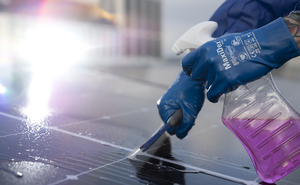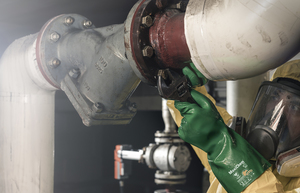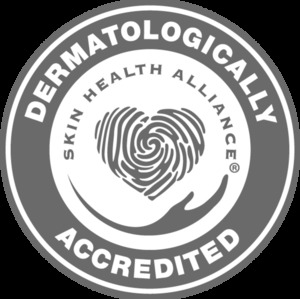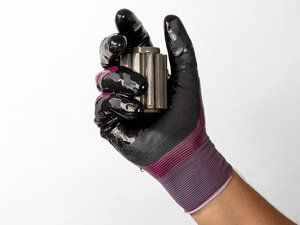
 |
Mark Sennett
Managing Editor |
 |
Kelly Rose
Editor |
Helping hands
23 July 2025
We use our hands every day at work, so protecting them is vital. Julie Roberts provides an insight into how health and safety professionals can protect these vital assets.

HANDS ARE the most valuable yet vulnerable tools in any working environment. From factories to warehouses, in garages or on building sites, hands are used in nearly every activity we perform - gripping, lifting, cleaning, typing, repairing, assembling.
This constant use puts hand skin under pressure. Daily exposure to the elements, water, chemicals, mechanical wear and tear, temperature extremes and repetitive movements, place a huge strain on the skin. Unlike any other body area, throughout the workday, skin on the hands is continuously exposed, overworked, and often insufficiently protected.
One of the most common consequences is occupational hand dermatitis - a painful, inflammatory condition that affects workers across multiple industries. It can lead to discomfort, work absence, reduced productivity, and in some cases, long-term illness.
As manufacturers of quality hand protection, we believe that understanding the risks - and responding with appropriate preventive measures - is a shared responsibility across the health and safety community.
Understanding hand skin health
The unique structure of hand skin
Your skin is the body’s largest organ, composed of three main layers: the epidermis, dermis and hypodermis. The structure and resilience of the skin varies across different parts of the body, and nowhere is this more true than on the hands.
Palms, for instance, are designed for friction and load-carrying. They posses a much thicker epidermis - up to ten times thicker than on other parts of the body – and they include the stratum lucidum, a unique layer found only on the palms, soles, and fingertips. These features provide durability but require specific protection.
Your palms contain a high density of sweat glands but no hair follicles, while the backs of the hands are thinner, contain hair follicles and are more prone to dryness and irritation. This anatomical distinction makes the skin on your hands extremely susceptible to damage - especially in the work environment.
How hand skin gets damaged
The outermost layer of the skin, the epidermis, functions like a brick wall. Skin cells are the bricks, and lipids (natural oils) serve as the mortar. This "skin barrier" retains moisture and protects against external aggressors.
Repeated exposure to water, soaps, chemicals, or friction can destroy this barrier by removing the natural oils, leading to dryness, cracking and inflammation. The damaged skin can then allow irritants, allergens and even organisms to penetrate more easily, exacerbating irritation and potentially causing infection.
Once irritated, the hands are more prone to further damage. Even something as simple as turning a key or gripping a tool becomes excruciating. Over time, this condition can develop into hand dermatitis (also referred to as hand eczema), which may be short-term or long-lasting.
The importance of hand hygiene in the prevention of illness is widely recognised, but it must be balanced with skin protection. Washing with soap and water can be drying, while alcohol-based hand sanitisers, though less disruptive to the skin’s lipids, are not universally effective against all types of germs. According to the World Health Organization (WHO), skin irritation is the most frequently reported barrier to effective hand hygiene in healthcare settings.
Dr Lisa Kirby, consultant dermatologist says, “Once the skin barrier becomes damaged, protecting the hands is very challenging. Restoring moisture is key but applying regular moisturisers can be difficult in real life - especially when at work. When the skin becomes cracked, it is really painful and creams and water can sting. Simple hand care measures can help to prevent hand dermatitis from occurring.”
Debunking myths
Myth 1: Only healthcare workers get hand dermatitis
While healthcare professionals are undoubtedly at risk due to frequent hand washing and glove use, many other industries face similar threats. Cleaners, food handlers, mechanics, engineers, and hairstylists all come into contact with detergents, solvents, grease, and wet work on a daily basis. All of these conditions can undermine the skin regardless of occupation.
A 2022 study published in the Journal of Occupational Health found that over 12% of motor vehicle repair workers had experienced occupational skin issues - evidence that dermatitis spans far beyond the clinical setting.
Myth 2: Hand dermatitis only affects people with eczema
Although individuals with a history of eczema may be more susceptible, hand dermatitis can affect anyone. Repeated exposure to workplace irritants can compromise even healthy skin. The WHO highlights skin irritation as a significant obstacle to maintaining proper hand hygiene, particularly in high-risk environments.
Myth 3: All protective gloves are the same
All gloves are not created equal. Different tasks require different materials, thicknesses, and levels of protection. For instance, nitrile gloves offer strong resistance against oils and chemicals, making them suitable for industrial applications. Vinyl gloves can work for brief, low-risk tasks, while fabric gloves with breathability serve to prevent sweating in hot environments.
Glove selection should be the basis of an appropriate risk assessment and in accordance with health and safety legislation and material safety data sheets (MSDS). Employers are advised to refer to guidance from the Health and Safety Executive (HSE) when choosing protective gloves.
The role of PPE
Personal Protective Equipment (PPE), such as gloves, is crucial in protecting workers’ hands from repeated exposure to hazardous chemicals such as oils and detergents. In most workplaces, such exposure is inevitable, and proper hand protection becomes unavoidable.
Under the Control of Substances Hazardous to Health (COSHH) Regulations, both employers and employees have legal duties to identify risk and implement controls. These include choosing gloves appropriate to the hazards and ensuring they remain comfortable and effective during use.
Gloves should be selected based on the specific activity: for food handling, thinner gloves may be preferred to allow dexterity; for chemical exposure, impermeable gloves should be worn but still allow grip.
Case Study: A mechanic’s experience with occupational dermatitis
J. Smith, a mechanic with two years’ experience, developed painful redness and blistering after routinely handling engine oil and coolants without gloves. Symptoms began as mild irritation but progressed quickly, eventually requiring two weeks off work for treatment with corticosteroids and emollients.
This case, highlighted by the Skin Health Alliance, underlines the real-world impact of inadequate hand protection. It reinforces the need for early intervention, regular glove use, and workplace education around hand care.
The impact of hand dermatitis
Hand dermatitis, also known as hand eczema, typically presents as itchy, dry, inflamed skin - most frequently on the palms but sometimes affecting other areas of the hand. The skin may be red or darker in tone, cracked, blistered, or swollen.
Individuals with a past history of childhood eczema (atopic eczema) or who engage in frequent “wet work” are at higher risk. The CDC estimates that contact dermatitis accounts for 90–95% of all occupational skin disease, with 80% of cases affecting the hands.
The consequences can be severe: lost working days, reduced quality of life, a negative impact on mental health, and in some cases, the need for a change of job or even early retirement.
The International Journal of Environmental Research and Public Health says “Among occupational diseases, 30–45% are skin diseases. Contact dermatitis accounts for the greatest part (95%) of occupational skin diseases.”
-
Practical tips
Assess the need for protection
Assess tasks involving water, chemicals, or mechanical stress. Periodically perform risk assessments so that any modifications are addressed.
- Choose the right gloves
Match the glove design and material to the specific hazard and task. Fit and comfort are essential - especially for long wear. - Practise good hand hygiene
Wash with mild, fragrance-free cleansers. Avoid over washing. Moisturise regularly, especially after hand washing. - Take regular glove breaks
Remove gloves periodically to allow the skin to breathe, especially when wearing liquid and chemical resistant gloves. - End-of-day skin care
Wash hands gently at the end of the day and apply an emollient or non-greasy moisturiser. - Adopt preventative habits
Wear gloves from the start, don’t adopt them halfway through your task. Avoid rings that trap moisture and chemicals against the skin. Wear gloves in cold weather to protect from the elements.
Emerging trends
As specialists in hand protection, ATG has made significant investment to address the key issues associated with skin health at work. Our focus is on minimising irritation, maximising comfort, and supporting long-term wellbeing through science-backed approaches.
Certified skin safety standards
We design our gloves to meet OEKO-TEX Standard 100 and adhere to European REACH regulations, ensuring they are free from harmful substances. In addition, ATG gloves are dermatologically accredited by the Skin Health Alliance, ensuring customers a higher level of reassurance through clinical third-party assessment.
The Skin Health Alliance says, “Skin Health Alliance accreditation involves a scientific review of a product’s ingredients, clinical data, and proof of efficacy. Our dermatological mark offers assurance that products are skin safe - not by brand claims, but through independent expert review.”
Clean production for skin confidence
ATG adopts a post-production glove washing process using harvested rainwater - treated and recycled in-house - to ensure gloves are fresh and clean straight from the pack. This removes residual chemicals and helps minimise irritation from first use.
Odour control and comfort features
To support long-term wear, ATG integrates odour control technologies such as Sanitized hygiene treatments into its glove linings - using only triclosan-free grades to enhance freshness while avoiding known skin irritants.
Environmental responsibility
Our commitment to sustainable hand protection includes developing gloves that can be laundered and reused multiple times - extending lifespan and reducing waste.
These efforts are designed not only to meet the functional needs of PPE but to enhance overall comfort, compliance, and skin health for wearers across at risk industries.
Hand skin health is a significant but often under-appreciated component of workplace safety. At ATG, we believe prevention is the most effective approach to managing occupational skin issues, combining the right glove technology with informed workplace habits.
By learning about the structure of hand skin, identifying risks, and taking easy preventative steps, organisations can help decrease cases of hand dermatitis and create a healthier workforce. Prevention is more than compliance - it’s a commitment to wellbeing.
For more resources, visit Skin Health Alliance – Know Your Skin and the CDC – Skin Exposure and Safety.
Julie Roberts is marketing manager at ATG. For more information, visit www.atg-glovesolutions.com/en
- No related articles listed



























